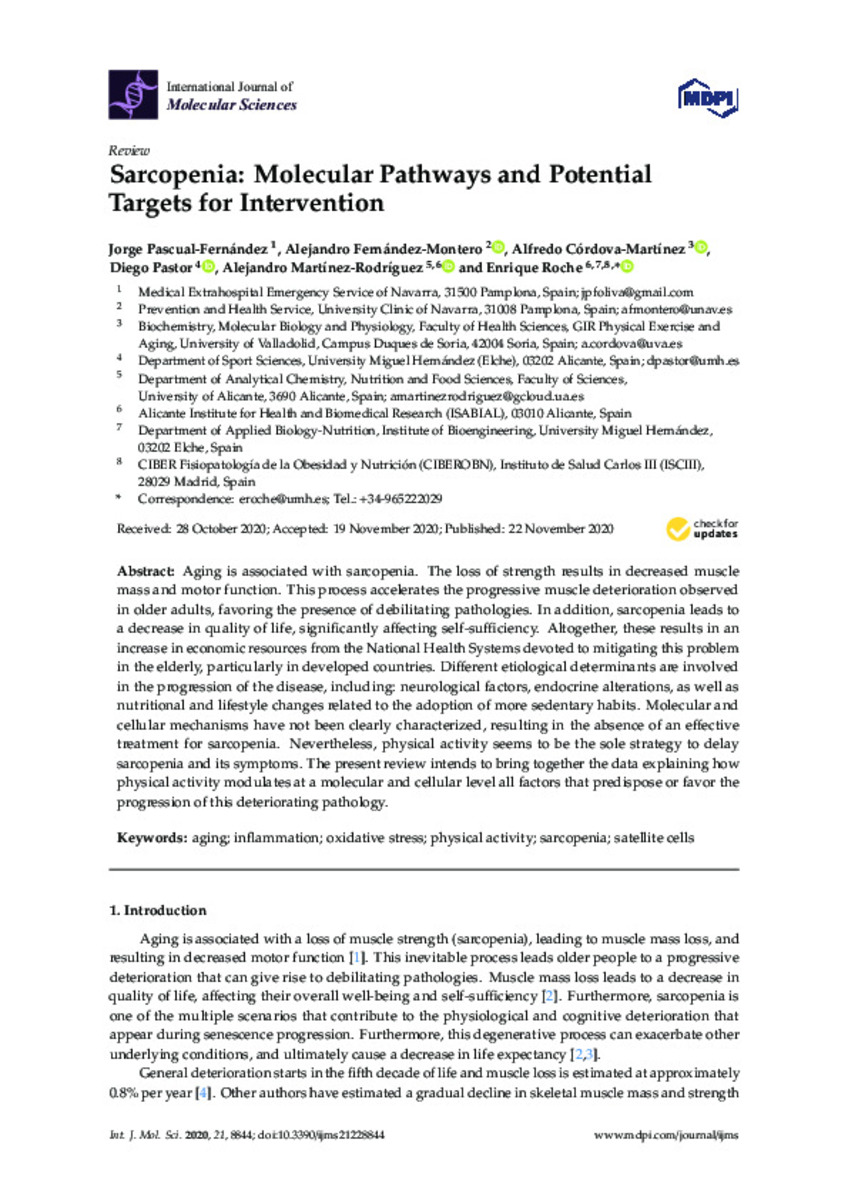Registro completo de metadatos
| Campo DC | Valor | Lengua/Idioma |
|---|---|---|
| dc.creator | Pascual-Fernández, J. (Jorge) | - |
| dc.creator | Fernandez-Montero, A. (Alejandro) | - |
| dc.creator | Córdova-Martínez, A. (Alfredo) | - |
| dc.creator | Pastor, D. (Diego) | - |
| dc.creator | Martínez-Rodríguez, A. (Alejandro) | - |
| dc.date.accessioned | 2023-05-30T07:31:57Z | - |
| dc.date.available | 2023-05-30T07:31:57Z | - |
| dc.date.issued | 2020 | - |
| dc.identifier.citation | Pascual-Fernández, J. (Jorge); Fernandez-Montero, A. (Alejandro); Córdova-Martínez, A. (Alfredo); et al. "Sarcopenia: molecular pathways and potential targets for intervention". International Journal of Molecular Sciences. 21 (22), 2020, 8844 | es |
| dc.identifier.issn | 1422-0067 | - |
| dc.identifier.uri | https://hdl.handle.net/10171/66461 | - |
| dc.description.abstract | Aging is associated with sarcopenia. The loss of strength results in decreased muscle mass and motor function. This process accelerates the progressive muscle deterioration observed in older adults, favoring the presence of debilitating pathologies. In addition, sarcopenia leads to a decrease in quality of life, significantly affecting self-sufficiency. Altogether, these results in an increase in economic resources from the National Health Systems devoted to mitigating this problem in the elderly, particularly in developed countries. Different etiological determinants are involved in the progression of the disease, including: neurological factors, endocrine alterations, as well as nutritional and lifestyle changes related to the adoption of more sedentary habits. Molecular and cellular mechanisms have not been clearly characterized, resulting in the absence of an effective treatment for sarcopenia. Nevertheless, physical activity seems to be the sole strategy to delay sarcopenia and its symptoms. The present review intends to bring together the data explaining how physical activity modulates at a molecular and cellular level all factors that predispose or favor the progression of this deteriorating pathology. | es_ES |
| dc.description.sponsorship | This study was supported by ISABIAL (grant number 190290) and the Official Funding Agency for Biomedical Research of the Spanish Government, Institute of Health Carlos III (ISCIII) through CIBEROBN (CB12/03/30038), which is co-funded by the European Regional Development Fund. | es_ES |
| dc.language.iso | eng | es_ES |
| dc.publisher | MDPI AG | es_ES |
| dc.rights | info:eu-repo/semantics/openAccess | es_ES |
| dc.subject | Aging | es_ES |
| dc.subject | Inflammation | es_ES |
| dc.subject | Oxidative stress | es_ES |
| dc.subject | Physical activity | es_ES |
| dc.subject | Sarcopenia | es_ES |
| dc.subject | Satellite cells | es_ES |
| dc.title | Sarcopenia: molecular pathways and potential targets for intervention | es_ES |
| dc.type | info:eu-repo/semantics/article | es_ES |
| dc.description.note | This article is an open access article distributed under the terms and conditions of the Creative Commons Attribution (CC BY) license (http://creativecommons.org/licenses/by/4.0/). | es_ES |
| dc.identifier.doi | 10.3390/ijms21228844 | - |
| dadun.citation.number | 22 | es_ES |
| dadun.citation.publicationName | International Journal of Molecular Sciences | es_ES |
| dadun.citation.startingPage | 8844 | es_ES |
| dadun.citation.volume | 21 | es_ES |
| dc.identifier.pmid | 33266508 | - |
Ficheros en este ítem:
Estadísticas e impacto
Los ítems de Dadun están protegidos por copyright, con todos los derechos reservados, a menos que se indique lo contrario.






